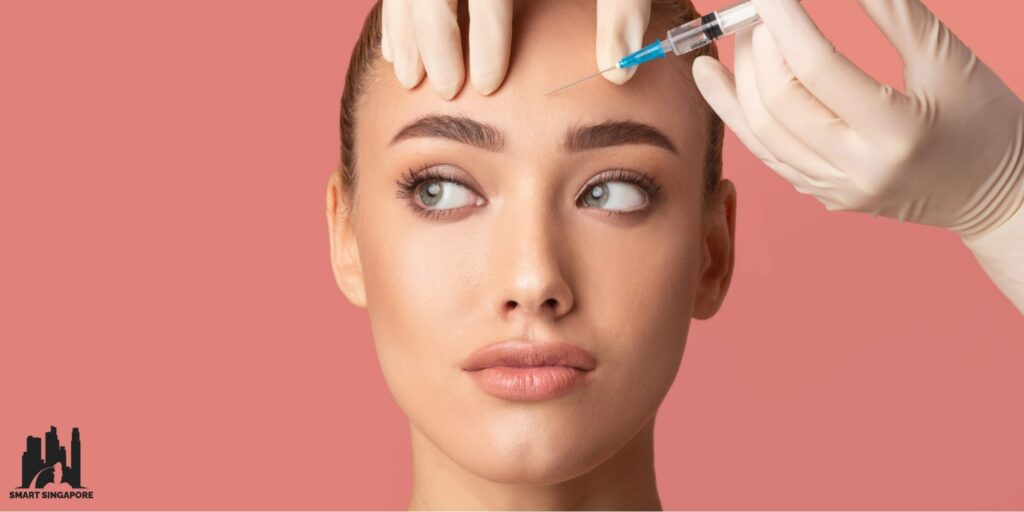Categories > Guides and Tips

Aesthetic Doctor vs Dermatologist: What’s the Difference?
- What is an aesthetic doctor?
- When do I need to see an aesthetic doctor?
- What is a dermatologist?
- When do I need to see a dermatologist?
- The Key Differences between an Aesthetic Doctor and a Dermatologist
- Branch of Medicine and Practice
- Training and Residency
- Cost and Insurance
- Treatment Types
- Aesthetic Doctor vs Dermatologist: Which One Is Better for Me?
Acne scars and fine lines are common skin issues most people face as they age. While countless skin products reverse these concerns, getting them checked out by a specialist is almost always the best practice.
Ideally, skin specialists should know the best treatment plan for your skin type, but achieving healthy skin goes beyond just facials and creams.
Maintaining healthy skin is crucial to living a better life. If your acne or wrinkles bother you and no skincare routine seems to be working, it’s high time to visit a clinic.
Chronic conditions may require medical attention, and when seeking treatment for them, people are at a crossroads between visiting an aesthetic doctor or dermatologist.
In hindsight, it’s easy to assume both branches of medicine are the same. However, there are stark differences between the two practices.
Want to find out which type of specialist to see for your skin needs? We’ve broken down the key differences between an aesthetic doctor and a dermatologist to get you started.
What is an aesthetic doctor?

An aesthetic doctor is a skin specialist who treats patients with cosmetic or beauty enhancement treatments to improve the external mien of your skin.
Simply put, aesthetic doctors focus more on enhancing and maintaining skin health. The most common services they provide are facials, hair removals, and laser treatments.
Aesthetic doctors are licensed practitioners who are highly trained in using minimally invasive to invasive techniques and tools.
While most beauty treatments are noninvasive, there are regulations and medical protocols where only licensed specialists can perform such procedures.
It also puts into perspective that certain treatments require specific training or certification from an aesthetic doctor before they can provide these services.
Botox, laser therapies, dermal fillers, and thread lifts are some aesthetic practices requiring further training. Certified aesthetic doctors generally train with dermatologists for these practices.
When do I need to see an aesthetic doctor?
You should see an aesthetic doctor if you want to enhance your skin’s natural state cosmetically or if your skin concerns can be treated without medical intervention.
Since aesthetic doctors focus more on the outward appearance of your skin, you should consult an aesthetic doctor if you want your skin concerns to be solved with beauty treatments.
You should also see an aesthetic doctor to learn how to use specific skincare products suitable for your skin type properly.
Consult an aesthetic doctor before testing beauty supplements or skincare products for the first time.
What is a dermatologist?

A dermatologist is a skin expert who treats and diagnoses skin-related conditions and issues that affect the nails and hair.
Dermatologists also treat skin complications following invasive procedures or traumatic injuries like scars, burns, and lesions.
Dermatologists who underwent specialised training can perform surgical procedures for skin cancer and biopsies.
Even with their elevated expertise in treating medical skin problems, dermatologists may also treat patients for cosmetic concerns.
There are several branches in dermatology, and each type caters to specific concerns based on factors like age and urgency.
For example, paediatric dermatologists generally attend to children and younger patients with skin issues.
Dermatologists can also lend their expertise to patients seeking medical advice from ear, nose, and throat specialists.
Procedures like reconstructive surgery or skin maintenance are procedures that dermatologists attend to.
When do I need to see a dermatologist?
You should see a dermatologist if you’re experiencing pain or swelling on a patch of skin or more extensive parts of your body.
Warning signs include moles that have changed in colour and size. Patches of skin that change shape are also common signs of skin cancer.
You should see a dermatologist for mild skin concerns if rashes or itchy, flaky skin doesn’t go away with regular topical solutions or home remedies.
Allergic reactions are also common issues that dermatologists treat. It’s essential to seek a specialist for stubborn skin conditions that don’t go away over time.
If you’ve been suffering from stubborn or cystic acne, you should consult a dermatologist about medications and treatments to help reduce inflammation and redness.
The Key Differences between an Aesthetic Doctor and a Dermatologist

| Aesthetic Doctors | Dermatologists | |
| Branch of medicine and practice | Cosmetic dermatology | Specialisations include surgical dermatology, paediatric dermatology, immunodermatology, and skin pathology |
| Training and residency | Undergo competency courses to carry out cosmetic procedures | Undergo post-graduate studies Accredited by the Ministry of Health in Singapore |
| Cost and insurance | Often not insurance claimable | Often insurance claimable |
| Treatment types | Beauty and wellness procedures Noninvasive treatments like Botox, laser therapies, dermal fillers, and thread lifts | Noninvasive and invasive treatments to treat all skin-related issues like acne, rashes, moles, and melanomas |
The key differences between a dermatologist and an aesthetic doctor in Singapore are the training, practice, treatments, and how much their services cost.
While there are subtle similarities between the two branches of dermatology, it’s important to distinguish their differences to determine which specialist to visit for your skin concerns.
1. Branch of Medicine and Practice
Dermatologists and aesthetic doctors are skin experts but have separate practices.
Most aesthetic doctors practice cosmetic dermatology, a branch of medicine that attends to the skin’s external appearance.
Many aesthetic doctors have diplomas and certifications that legally enable them to perform intense beauty treatments.
Aesthetic doctors also practice in private clinics or wellness centres that offer skin treatments and other beauty and wellness procedures that target a patient’s overall well-being.
Aesthetic clinics may also offer customised treatment plans, benefiting patients seeking more overall beauty enhancements.
On the other hand, dermatologists practice in both private and public clinics. Many of their treatments can be subsidised, granted that the procedure is medically necessary.
Dermatologists also get accredited by the Ministry of Health in Singapore, enabling them to perform invasive treatments to treat all skin-related issues.
2. Training and Residency
Dermatologists and aesthetic doctors go through medical training and have degrees in medicine.
However, dermatologists are specialists who underwent post-graduate studies and exams that certify their skills in performing more medically necessary procedures.
Dermatologists can also branch out to specialisations in dermatology, such as surgical dermatology, paediatric dermatology, immunodermatology, and skin pathology.
Dermatologists are certified medical doctors who provide life-changing care for patients with delicate conditions like skin cancers and side effects of chronic diseases like jaundice and diabetes.
Dermatologists are also trained in treating diseases affecting your nails and hair.
While aesthetic doctors generally advise patients on how to care for them properly, dermatologists can prescribe treatments to help solve mild to severe nail and hair issues.
Aesthetic doctors are also certified specialists but undergo training for cosmetic procedures.
These specialists must complete competency courses to carry out cosmetic procedures that may have side effects on patients.
Many beauty treatments require the use of medical equipment, as well. These tools have specific protocols and varying wattages that only licensed aesthetic doctors can use on patients.
This is because each patient is unique and aesthetic doctors need to determine the correct dosage of medication, solutions, and even radiofrequency strength to properly treat their patients’ skin concerns.
Dermatologists and aesthetic doctors also have different target patients. Since dermatologists generally treat skin-related problems, their practice is often open to patients of all ages and backgrounds.
Aesthetic doctors, however, can perform beauty enhancements and cosmetic treatments granted that patients undergo critical assessment.
This is because not all patients can undergo specific cosmetic procedures due to pregnancy, young age, or underlying health problems that render them ineligible for treatment.
3. Cost and Insurance
The cost of seeing a dermatologist differs from seeing an aesthetic doctor. While some private clinics offer both practices, you’ll notice varying price ranges depending on the treatment you want.
Dermatologists medically treat skin conditions of varying severity. Many of their patients generally see them for skin conditions that affect their health, such as stubborn rashes and cancers.
Thus, these medically necessary procedures are often insurance claimable. They may be pricey when paid out of pocket, but the treatments can be subsidised, depending on the type of clinic you visit.
Aesthetic doctors perform cosmetic procedures, which aren’t often insurance claimable. Depending on the procedure type, many patients require several treatment sessions for better results.
That said, aesthetic treatments can be expensive, especially for procedures requiring top-notch equipment.
Some dermatology clinics may have specific price ranges for you if you’re a foreigner. Subsidised care is not available for international clients, but insurance policies may cover a certain amount.
On the other hand, aesthetic clinics commonly offer promotions on their treatments. For example, if you’re visiting an aesthetic doctor for Botox, they may offer discounts if you avail of another similar treatment type.
4. Treatment Types
Dermatologists are certified to perform treatments on acne, rashes, moles, and melanomas. When necessary, surgery is also a standard procedure that dermatologists attend.
Determining your skin type is crucial in knowing what treatments are appropriate for your condition.
Aesthetic doctors often adjust their treatments according to your skin type and use specific dosages or wattages to prevent harming your skin.
Many aesthetic treatments have specific patient criteria. Even if your skin is generally healthy, aesthetic doctors have the right to refuse to treat your skin if you’re underaged or have underlying health conditions.
Aesthetic doctors mainly perform noninvasive treatments like Botox, laser therapies, dermal fillers, and thread lifts.
These treatments don’t require hospital admission and can be done in a day. Dermatologists, however, might require admission if the treatment is invasive, like surgery.
Dermatologists may assess patients further to determine the root causes of their skin diseases. More often than not, skin issues can be typical signs of other serious illnesses, and dermatologists can refer a specialist for treatment.
Aesthetic Doctor vs Dermatologist: Which One Is Better for Me?

Getting treated by a skin specialist is a great way to maintain the overall health of your skin. Since it’s the largest organ in your body, it’s crucial to take care of it daily.
Seeing a dermatologist or aesthetic doctor regularly is good practice, but when skin issues that disrupt your daily life occur, it’s essential to know which doctor to see.
If you want to maintain the health of your skin by reducing fine lines or inducing collagen production, it’s best to see an aesthetic doctor.
Aesthetic doctors can also educate you on properly using skin care products and maintaining a healthy glow based on a diet.
Beauty enhancements, although inherently good, shouldn’t be done in excess. Aesthetic doctors will guide you through the pros and cons of each treatment so that you don’t overtreat your natural skin barriers.
A dermatologist may be a better option if you have chronic skin conditions that minimally invasive procedures can’t treat.
It’s best practice to have a dermatologist check on growing moles or inflamed skin for better maintenance.
While dermatologists can also give helpful advice on caring for your skin correctly, they can also prescribe medications and topical solutions to reduce pain or discomfort over time.
When searching for a skin clinic, it’s also best practice to do your research on the types of treatments they offer.
Many clinics have both aesthetic doctors and dermatologists helming them, giving you an advantage when you’re not sure which specialist to pick.
Both doctors can help you determine the best treatments for your skin health. Knowing your symptoms and skincare needs leads to a better understanding of which specialist is right for you.





